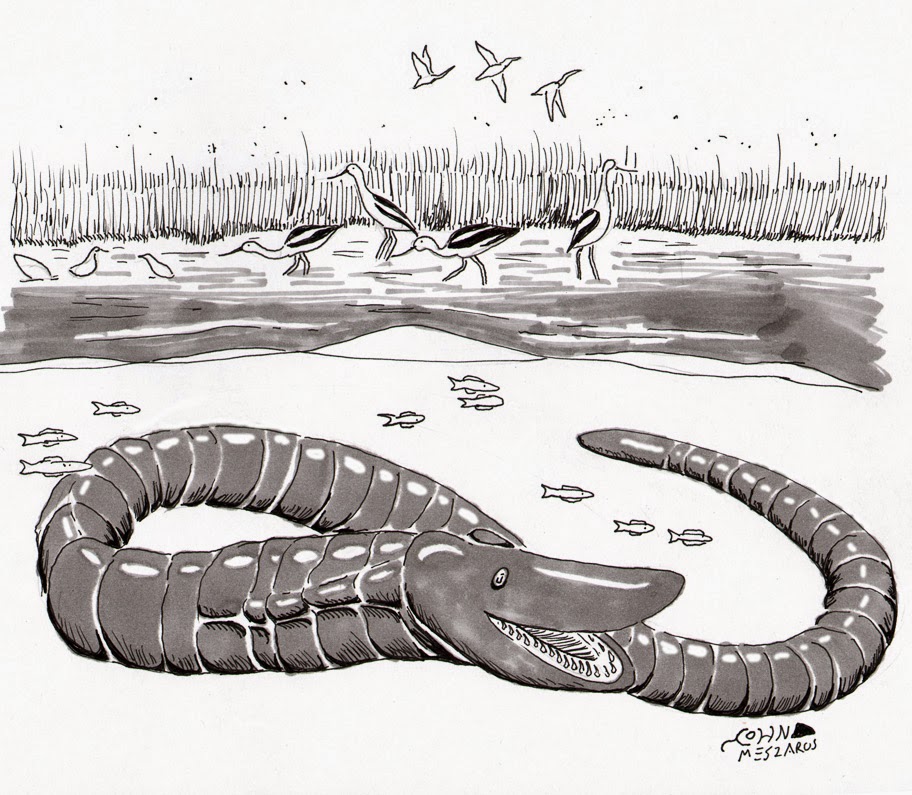
Sinkhole Sam
Sinkhole Sam is a 15 foot long snake or worm-like creature that is said to reside in Inman's Big Sinkhole, a small pond that used to be a part of Inman Lake. Sam is usally described as 15 feet long and about as big around as a tire with a fluked tail and a "non-snake-like grin". The creature was first sighted in the 1920s by fishermen, but the most well documented report happened in 1952, when a pair of mennonite boys saw the creature, and one of them shot at it with his 22. rifle, but it seemed to have no effect on the creature. After that, people began flocking to the sinkhole in the hopes of seeing the best for themselves. It's been almost a hundred years since Sam was first sighted, and it's been almost just as long since he was last sighted. Nowadays the story is almost completely forgotten.
Sinkhole Fever of the 1950s
While reports of a strange creature living in the big sinkhole began in the 1920s, the most well documented case happened in 1952. Two mennonite boys, Albert Neufeld and George Regehr, were fishing at the big sinkhole when they spotted Sam. Regehr had seen the creature from a bridge that stretches a little over the sinkhole, while Neufeld took two shots at it with his 22. calibur rifle, and he insisted that he had hit the beast. Sam then disappeared as quickly as he had appeared. News began to spread of the story, and masses of people began to gather around the sinkhole, parking around the water's edge and watching the surface from the safety of their cars, hoping to gatch a glimpse of the elusive serpent. Later that year a story was published in the Salina Journal written by Ernest Alva Dewey. Had already written multiple stories poking fun at cryptids and other paranormal events. Most notably, he had written an article where he explained that UFO sightings were attributed to a species of dragon called the "ball-tailed snickelhoopus". In his article covering Sinkhole Sam, he claimed to have gone out to the Big Sinkhole with Dr. Erasmus P. Quattlebaum, (fictional) who explained that Sam was simply a "foopengerkle", a species of extinct subterrainian animal that were vegetarians and quite unintelligent. In fact, it seemed Sam was so stupid that he didn't know he was already extinct. Obviously Dewey wasn't taking the original account seriously, but who can blame him, but what really happened at the Big Sinkhole? While it seems stories of something in the Big Sinkhole began in the 1920s, information from this time period is extremely scarce, and information from 1952 is very limited. However, there's a very good chance that Neufeld and Regehr had seen something. First of all, they're mennonites, a group of honest, religious folks who try not to draw too much attention to themselves, and limit themselves on technology, so it seems very unlikely that these would be the type of people to make up some crazy story like this for attention. There is always the chance of course, but it seems unlikely. This leaves two possibilities, misidentification or Sinkhole Sam is real. Many have theorized that Sam was some species of large snake, perhaps an exotic species; some kind of constrictor. Or perhaps it was actually a large catfish, or maybe even a log. This story isn't the beginning of Sam's legacy, so perhaps the excitement led to a misidentification, but we will never truly know what happened that day in 1952.

The Big Sinkhole Today
These days, Sinkhole Sam is only remembered by people who have a facination for cryptids; it's "the Kansas cryptid". But even among cryptozoologists, it's quite an obscure tale. In his hometown of Inman, he's practically forgotten. A legend burried by time. Similarly, the Big Sinkhole itself has also been forgotten. Both times that I've visited the sinkhole there has been very little sign of human activity. No trash, no snagged or lost fishing gear, nothing of the sort. Just the occassional boot print in the mud. On my most resent visit, I found the sinkhole almost entirely dried up. Being able to walk along the bottom of the sinkhole helps shed some light on it. While there are still species of freshwater mollusks, there are no fish, alive or dead. The sinkhole is also only about four to five feet in depth, maybe even less. It really doesn't live up to the title of the "big sinkhole". Seeing it dried up these days, it's hard to image a monster living there. Interestingly enough, many of the articles mention that there had been a drought around the time people were gathering in the hopes of seeing the creature. Whatever Sinkhole Sam may have been, it's hard to imagine that he still remains after all these years.